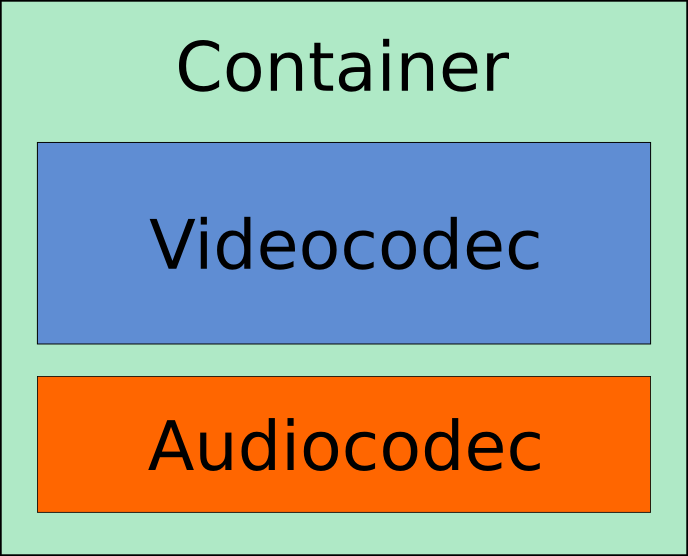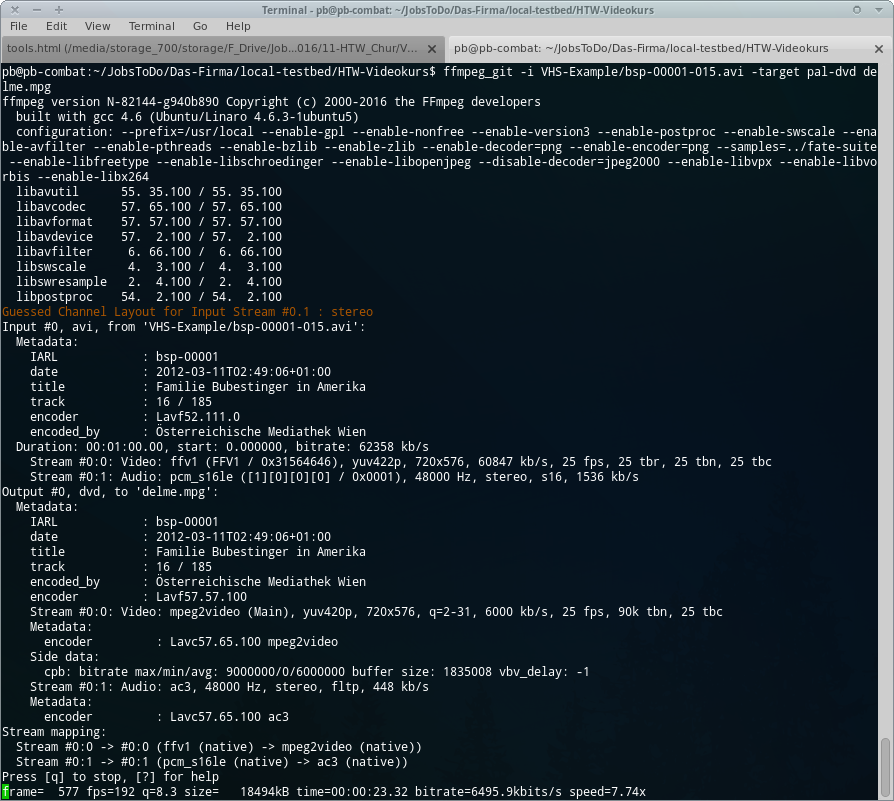FFmpeg Grundlagen

Inhaltsübersicht
- Einführung
- Umpacken
- Transcodieren
- Bildformat ändern
- A/V trennen
- Ausschnitte
FFmpeg? Wosisdes?
Das FFmpeg-Projekt besteht aus einer Reihe von freien Computerprogrammen und Programmbibliotheken, die digitales Video- und Audiomaterial aufnehmen, konvertieren, senden (streamen) und in verschiedene Containerformate verpacken können.
Unter anderem enthält es mit libavcodec eine umfangreiche Sammlung von Audio- und Videocodecs.
Quelle: Wikipedia: FFmpeg
Wo kriegt man's her?
...vom "Bio-Bauernmarkt".
ffmpeg.org/download.html
Digital Video Trinity

Basis Syntax
ffmpeg [-y] -i INPUT_FILE [PARAMETER] [-f FORMAT] OUTPUT_FILE
FFmpeg, was kannst Du?
- Liste Container:
-formatsFile formats: D. = Demuxing supported .E = Muxing supported - Liste Codecs:
-codecs/-encoder/-decoderCodecs: D..... = Decoding supported .E.... = Encoding supported ..V... = Video codec ..A... = Audio codec ..S... = Subtitle codec ...I.. = Intra frame-only codec ....L. = Lossy compression .....S = Lossless compression
Videofile: Was is drin?
ffmpeg -i INPUT_FILE -hide_banner
ffmpeg version 4.0.1-static https://johnvansickle.com/ffmpeg/ Copyright (c) 2000-2018 the FFmpeg developers built with gcc 6.3.0 (Debian 6.3.0-18+deb9u1) 20170516 configuration: --enable-gpl --enable-version3 --enable-static --disable-debug --disable-ffplay --disable-indev=sndio --disable-outdev=sndio --cc=gcc-6 --enable-fontconfig --enable-frei0r --enable-gnutls --enable-gray --enable-libaom --enable-libfribidi --enable-libass --enable-libvmaf --enable-libfreetype --enable-libmp3lame --enable-libopencore-amrnb --enable-libopencore-amrwb --enable-libopenjpeg --enable-librubberband --enable-libsoxr --enable-libspeex --enable-libvorbis --enable-libopus --enable-libtheora --enable-libvidstab --enable-libvo-amrwbenc --enable-libvpx --enable-libwebp --enable-libx264 --enable-libx265 --enable-libxml2 --enable-libxvid --enable-libzimg libavutil 56. 14.100 / 56. 14.100 libavcodec 58. 18.100 / 58. 18.100 libavformat 58. 12.100 / 58. 12.100 libavdevice 58. 3.100 / 58. 3.100 libavfilter 7. 16.100 / 7. 16.100 libswscale 5. 1.100 / 5. 1.100 libswresample 3. 1.100 / 3. 1.100 libpostproc 55. 1.100 / 55. 1.100
Input #0, mov,mp4,m4a,3gp,3g2,mj2, from 'input.mp4':
Metadata:
major_brand : mp42
minor_version : 0
compatible_brands: isommp42
creation_time : 2016-10-19T17:32:00.000000Z
Duration: 00:00:12.05, start: 0.000000, bitrate: 16964 kb/s
Stream #0:0(eng): Video: h264 (High) (avc1 / 0x31637661),
yuv420p, 1920x1080, 17011 kb/s,
30.02 fps, 30 tbr, 90k tbn, 180k tbc (default)
Metadata:
creation_time : 2016-10-19T17:32:00.000000Z
handler_name : VideoHandle
Stream #0:1(eng): Audio: aac (LC) (mp4a / 0x6134706D),
48000 Hz, stereo, fltp, 128 kb/s (default)
Metadata:
creation_time : 2016-10-19T17:32:00.000000Z
handler_name : SoundHandle
At least one output file must be specified
Umpacken
ffmpeg -i INPUT_FILE -c copy OUTPUT_FILE
ffmpeg -i INPUT_FILE -c:v copy -c:a copy -map 0 OUTPUT_FILE

Codec
- Videocodec:
-c:v CODEC - Audiocodec:
-c:a CODEC - A + V 1:1 kopieren:
-c copy -map 0
Transcodieren
ffmpeg -i INPUT_FILE -c:v ffv1 -c:a pcm_s24le OUTPUT_FILE
ffmpeg -i INPUT_FILE -c:v ffv1 -c:a pcm_s16le OUTPUT_FILE
Video 1
- Auflösung:
-s WIDTHxHEIGHT - Seitenverhältnis:
-aspect X:Y - Framerate:
-r FPS
Bildformat ändern
ffmpeg -i INPUT_FILE -c:a copy -c:v ffv1 -s 720x576 OUTPUT_FILE
ffmpeg -i INPUT_FILE -c:a copy -c:v ffv1 -aspect 4:3 OUTPUT_FILE
ffmpeg -i INPUT_FILE -c:a copy -c:v ffv1 -r 30000/1001 OUTPUT_FILE
Video 2
- Farbmodell/tiefe:
-pix_fmt FORMAT
pix_fmt?
- yuv422p = YUV 4:2:2 planar
- yuv420p
- yuv422p10le
- yuv420p10le
- yuva422p
- Keep-or-die:
-pix_fmt + - Liste:
-pix_fmts
Subsampling ändern
ffmpeg -i INPUT_FILE -c:v ffv1 -pix_fmt yuv422p OUTPUT_FILE
(Achtung: re-encoding)
A/V separat
- Video 'None':
-vn - Audio 'None':
-an
Audio
- Audiocodec:
-c:a CODEC - Samplerate:
-ar SAMPLERATE - Kanäle:
-ac CHANNELS - Bitrate:
-b:a BITRATE{k,M}
A/V separat
Video 3
- Bitrate:
-b:v BITRATE{k,M} - Bitrate (min):
-minrate BITRATE - Bitrate (max):
-maxrate BITRATE - GOP size:
-g FRAMES
Video Ausschnitte
- Startposition:
-ss DURATION - Rückwärts:
-sseof DURATION - Länge:
-t DURATION
DURATION:
Timecode: [-][HH:]MM:SS[.m]
oder
Sekunden: [-]S[.m]
Video Ausschnitte
- Start Offset:
ffmpeg -ss DURATION -i INPUT_FILE -c copy OUTPUT_FILE - Nur Anfang:
ffmpeg -t DURATION -i INPUT_FILE -c copy OUTPUT_FILE - Offset + Länge:
ffmpeg -ss DURATION -t DURATION -i INPUT_FILE -c copy OUTPUT_FILE
Transcoding II
"MPEG-4" (H.264)
"x264 H.264/MPEG-4 AVC encoder wrapper. [...]
libx264 supports an impressive number of features, [...]"
- Codec:
-c:v libx264 - Bitrate:
-b:v BITRATE{k,M} - CRF:
-crf 0 (lossless) - 51 (worst) - Presets:
-preset:v {ultrafast,superfast,veryfast,faster,fast,medium(*),slow,slower,veryslow} -
Feintuning:
-tune {film,animation,grain,...}
Quellen/Links: FFmpeg Wiki, FFmpeg docs
"Ein MPEG-4 bitte."
(H.264 / AAC in MP4)
ffmpeg -i INPUT_FILE -c:v libx264 -preset:v superfast -crf 22
-c:a aac -b:a 192k OUT.mp4
Haltbarkeit?
In a nutshell
- Gebranntes (CD/DVD/BluRay): Nix gut.
- HDD im Kastl: Nix gut.
- Container verlustfrei (!) umpacken.
- Generationsverluste vermeiden.
- Audio: PCM
- Lossless falls möglich (FFV1).
- Offene Formate! (+ git clone FFmpeg)
- Hashcodes. MD5 reicht.
- Backup-Kopien.
Links
License and Credits
Der Text dieser Präsentation steht unter einer freien Lizenz zur Verfügung:
Creative Commons "Attribution-ShareAlike"
(CC-BY-SA)

Peter Bubestinger-Steindl
pb@fsfe.org